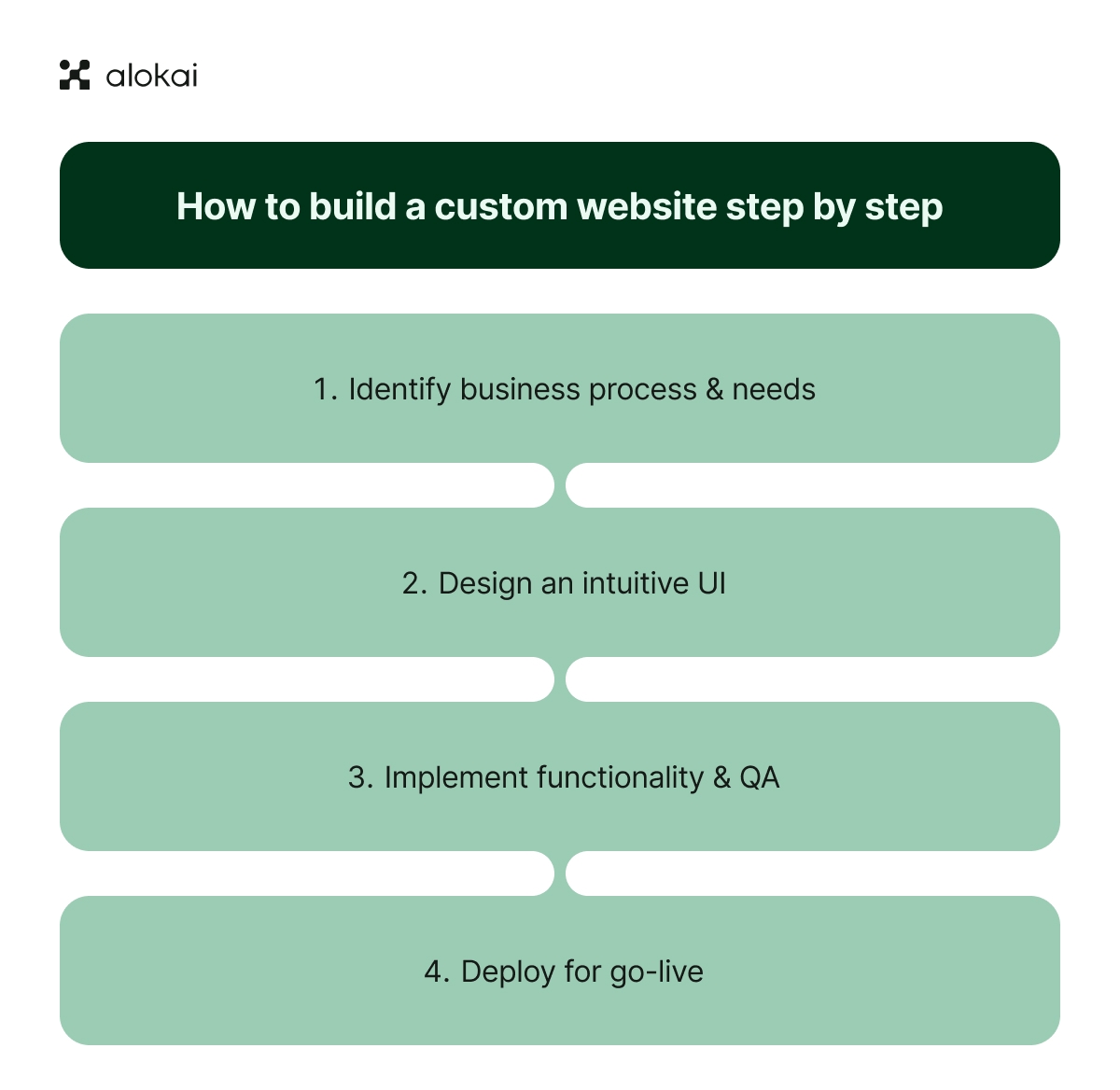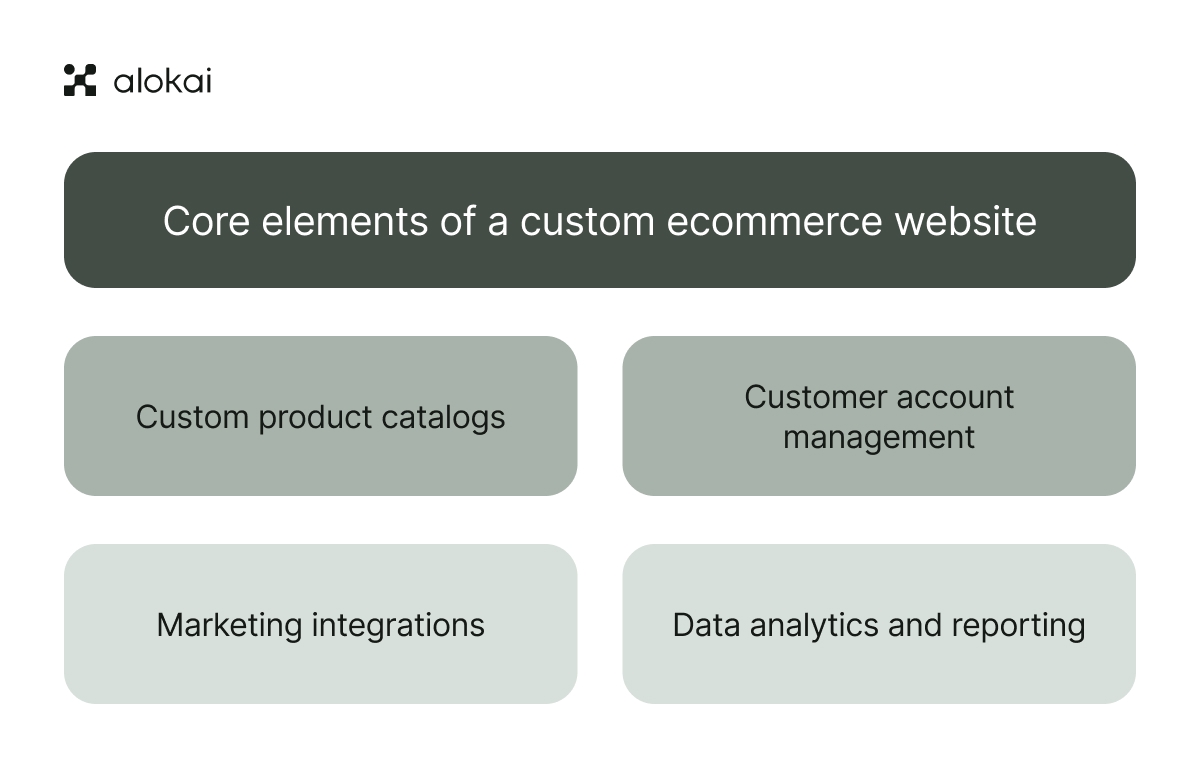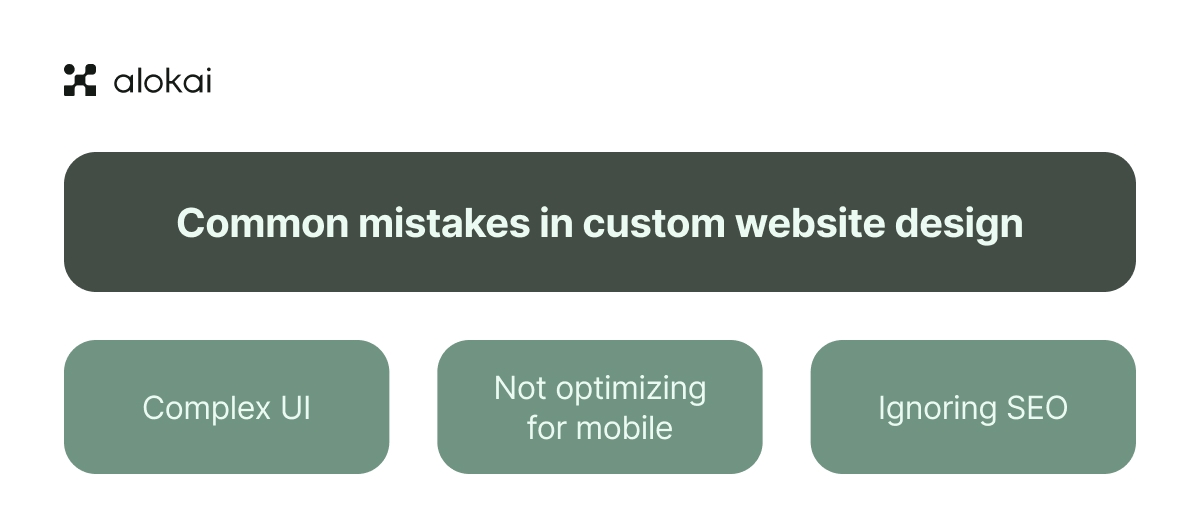Unlike generic templates, a custom-built website offers clients a tailored approach, aligning with your brand identity and giving a unique, personalized shopping experience to customers. With growing client expectations and the need to stand out, custom design can be the key to unlocking higher engagement and better sales performance.
In this article, we'll walk you through the benefits of custom ecommerce development, critical elements that make a successful site, and what to expect in terms of cost and development time. Let’s get started!
What is custom ecommerce design?
Custom ecommerce design is all about creating a unique online store that’s tailored specifically to your business.
Unlike using cookie-cutter templates, a custom-designed ecommerce website is built from the ground up to reflect your brand, meet your customers' needs, and deliver a one-of-a-kind shopping experience in line with current ecommerce trends.
With custom ecommerce web development, you have full control over everything – from the way your site looks and feels to how it functions. You’re not stuck with limited features or layouts. Instead, you can create something that truly represents your brand and helps you stand out in a crowded marketplace.
5 benefits of choosing a custom ecommerce website design
Custom websites are about much more than just a pretty design. They give you more control over every aspect of your online store, making sure it works for both the business side and the customers.
Here are 5 key benefits you’ll enjoy when you go the custom route:

1. Enhanced user experience
People shop online because it's convenient; if your website is clunky or hard to navigate, customers are likely to abandon it and look for what competitors have to offer.
Unlike generic templates that try to be everything for everyone, a custom ecommerce platform allows you to design a layout that makes it easy for users to find products and complete their purchases.
Custom design also makes it possible to integrate smart features such as recommendations based on users' browsing and purchase history, giving customers a more relevant shopping experience that keeps them coming back.
Current cart abandonment rates are high, with an average of 7 out of 10 shoppers leaving purchases uncompleted – the smoother the overall user experience, the more likely customers are to finish their orders.
2. Better alignment with brand identity
Your ecommerce website is an extension of your brand. With custom ecommerce development, you can create frontend that reflects your brand's personality, values, and mission, building a memorable shopping experience that clicks with your target audience.
When clients feel connected to your brand through a personalized experience, they are more likely to return and stay with your brand long-term. If you use a pre-built template, your website might end up looking similar to hundreds of other stores, and fail to leave an impression.
With a custom design, you get a unique look and feel that sets you apart from competitors and leaves a lasting impression on your visitors; every element, from the color scheme to typography and imagery, can be customized to align with your brand identity.
3. Scalability and flexibility for online store growth
One of the biggest challenges with out-of-the-box ecommerce platforms is that you’re often limited in how much you can grow or how easily you can adapt to changes. With a custom website, you can easily handle new integrations, third-party tools, and expand your store’s capabilities as your business evolves.
It’s obvious that as your business becomes bigger, so do your needs. A custom solution gives you the flexibility to scale up server capacity, handle more traffic, and add new functionality with no major impact on website performance.
You can add new features, product lines, or services without disrupting the customer experience or having to overhaul the entire site.
4. Better security and control over functionality
When it comes to ecommerce stores, security is non-negotiable. Data breaches and cyberattacks are all too common, and they damage both finances and reputation.
A custom ecommerce architecture gives you more control over security measures. You can integrate specific security protocols, such as SSL certificates or PCI-compliant payment gateways. You can also manage how data is stored, processed, and protected. This helps minimize risks and gives your customers the peace of mind they need when shopping.
Custom development also allows you to stay on top of updates and ensure that your site meets the latest security standards.
5. Enhanced website speed and SEO
Slow-loading websites are one of the top reasons for abandoned carts, and page speed is a key factor in how well your site ranks on search engines. With a custom website, you have the ability to optimize every element to ensure fast load times and superior SEO performance.
Custom websites are built to your specifications, which means you won’t have to deal with bloated code or unnecessary plugins that slow down your site.
It’s also worth mentioning that as mobile shopping continues to grow, having a mobile-optimized ecommerce website is essential for SEO. Custom websites give you the flexibility to design a fully responsive, mobile-friendly experience, improving your site’s rankings and ensuring a smooth customer experience.
How to build a custom ecommerce website? Design, development, and key features
Building an ecommerce store is a detailed, step-by-step process that takes your vision from a simple idea to a fully functional online store. Here’s what to expect:

1. Identifying business processes and requirements
First things first: you’ll need to define exactly what you want out of your ecommerce website. Who are your customers? What’s their shopping journey like? What features are absolutely essential for your business?
This stage involves understanding your target audience, your ecommerce business objectives, and how the website will support them. It’s also where you’ll map out the must-have features like specific payment methods, shipping options, customer service tools, etc.
2. Designing an intuitive user interface
Once you’ve mapped out your business requirements, it’s time to move to design. This is where the creative part of the process begins, as the design team works on creating a layout that is visually appealing and user-friendly. The focus here is on making sure that the website is easy to navigate and provides a seamless shopping experience for users.
Before jumping into design, you'd also have to prepare wireframes to map out the structure of the website. Prototypes may also be developed to simulate the user experience and provide a better understanding of how the site will function once it’s live.
3. Implementing functionality and testing for quality
At this stage, the site is not only about aesthetics but mostly about how it performs behind the scenes. With the design locked in, developers get to work building the custom functionalities you need – whether it’s product customization options, secure checkout processes, or specific integrations like CRM systems.
No ecommerce store should go live without proper testing. Functionality tests ensure that everything works as intended, while load testing guarantees that your site can handle high traffic.
4. Deployment and launch
Once the website has been thoroughly tested and is ready for prime time, the final step is deployment and launch. This involves moving the website from a staging environment to a live server and making it accessible to the public.
Launching a website is not a one-time event; it’s an ongoing process that involves continuous monitoring and optimization. The development team will likely monitor your website for any issues and perform necessary updates to keep it running at peak performance.
Key elements of a successful custom ecommerce website
It’s the features and functionality that really make an ecommerce store a success. Here are the 4 key elements you need to nail:

1. Custom product catalogs
The product catalog is one of the most important components of an ecommerce website.
A custom design lets you display your products in a way that makes sense for your business. Instead of relying on a standard template, you can create custom product listings, as well as use advanced filtering, personalized recommendations, and custom categorization to highlight your top-selling or seasonal items.

2. Streamlined customer account management
Customers appreciate having control over their accounts; the easier you make it for them, the better. Let customers easily track orders, save favorite items, and manage their account details. This improves the overall user experience and can encourage repeat purchases.
You can even offer personalized recommendations based on previous purchases or browsing history, making the experience more tailored to individual customers.

3. Marketing integrations
Custom ecommerce websites also provide the opportunity to integrate powerful marketing tools directly into the platform, and you should make the most of it. This could include email marketing services, SMS notifications for special offers, or social media sharing features.
You can automate marketing campaigns, track customer engagement, and create personalized promotions to boost your sales efforts – all within a unified system.

4. Analytics and reporting for data-driven decisions
You can’t improve what you can’t measure; a successful ecommerce website should come with built-in analytics tools that allow you to track everything from traffic to conversion rates.
By integrating tools like Google Analytics, heatmaps, and custom dashboards, you can gain insights into customer behavior, popular products, and where you might be losing sales. This data can guide your decisions, helping you tweak your website design, marketing strategies, and product offerings.

Common mistakes to avoid in custom ecommerce website design
Even with the best strategies, custom ecommerce websites can run into some common pitfalls. These mistakes often stem from a desire to add too much or from overlooking crucial elements during the design phase.
Let’s dive into some of the most frequent errors and how you can avoid them:

1. Overcomplicating the user interface
When it comes to designing online stores, It’s easy to fall into the trap of adding too many features. However, cluttering your site with too much fluff can overwhelm users and lead to decision fatigue.
In fact, too many options can make navigation confusing and slow down your website's load time, which is a huge turn-off for online shoppers.
Remember: a clean and intuitive interface is key to a positive user experience. Focus on clear navigation, minimal distractions, and guiding users toward your most important products or calls to action.
Make sure that every feature or button serves a purpose and adds value to the shopping journey. The goal is to make shopping smooth and enjoyable, not overwhelming.
2. Neglecting mobile optimization
More and more consumers are shopping via mobile, with over 75% of Americans already using smartphones for shopping. A desktop-only design might look good on a large screen, but if it doesn’t translate well to mobile devices, it can become a frustrating ecommerce experience for mobile shoppers.
Start with mobile in mind, designing layouts and user journeys that are intuitive for smaller screens, and make sure your site automatically adjusts to fit any screen size. Responsive design not only improves the UX but also contributes to better SEO rankings, as Google prioritizes mobile-friendly sites.
3. Failing to focus on SEO from the outset
One of the biggest mistakes businesses make is treating search engine optimization as an afterthought.
SEO should be woven into the fabric of your custom website from the very beginning as without a solid SEO foundation, it’s way harder for potential customers to find your store organically.
A well-organized site hierarchy helps both users and search engines. Categories, subcategories, and product pages should follow a logical flow, making it easier for users to navigate and for engines to crawl and index your site effectively.
Ensure that every page of your ecommerce site is optimized with relevant keywords, meta descriptions, alt text for images, and clean URL structures. These elements help search engines understand what your pages are about, improving your chances of ranking higher in search results.
How much does it all cost? The budget and timeline for developing a custom ecommerce website
When you’re building a custom ecommerce platform, costs and timelines can vary significantly, depending on what you need.
It’s important to understand that every feature, design element, and customization impacts both the budget and the time required. Depending on complexity, the cost can range anywhere from tens to hundreds of thousands of dollars.
Let’s explore the key factors that will influence your budget and timeline:
Website complexity: The simpler the website, the less time and money it will take to build. The more you add to the site, the more lengthy and costly the development becomes.
Custom features: The more custom features you want, the more development work is required. Take the time to decide what features you need exactly, and how they’ll influence the budget and time needed to develop them.
Third-party integrations: If you’re using tools like a specific CRM, accounting software, or custom shipping options, these will need to be integrated into your website. More integrations mean more development time, and again – more resources.
Scalability: Planning for future growth is key. If you expect to expand your business, building a scalable website upfront might require a higher initial investment, but it’ll save you from costly upgrades down the road.
Development team expertise: More experienced developers might charge higher rates, but they can deliver a better, faster product – saving you time and headaches in the long run.
It’s important to note that while custom solutions offer flexibility, they often come with longer timelines and complex development processes. If you want the benefits of custom website development without the hassle that comes with it, consider Alokai’s solution.
With Alokai’s Composable Storefront, you get the perfect balance – a flexible, modular solution that feels like a custom design, but with the speed and ease of out-of-the-box components.
The solution is built for scalability and fast deployment, so you can launch your store quickly without compromising on performance or customer experience. It’s the ideal middle-ground option for businesses that want to get online fast, but still need the flexibility to grow and adapt to changing customer demands.
Conclusion
Investing in custom ecommerce website design is vital for businesses aiming to stand out in today’s crowded online marketplace.
A tailored approach not only improves user experience but also reflects your brand's unique identity, setting you apart from those using generic templates. By focusing on custom features and distinctive design, you can create online stores that enhance customer engagement and support business growth.
Ultimately, a well-designed ecommerce site can make a significant difference in how customers see your brand and interact with your products; it’s a business benefit that you shouldn’t overlook.













